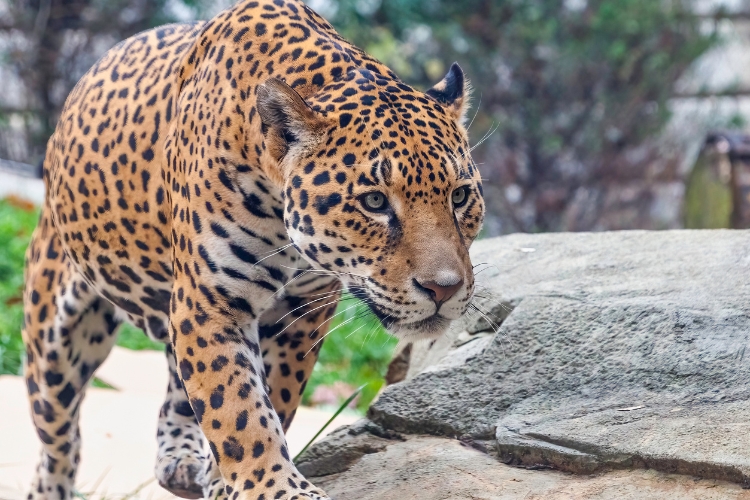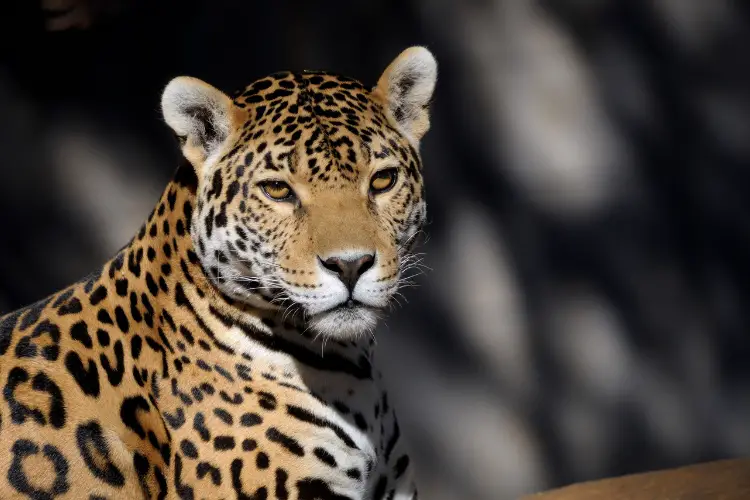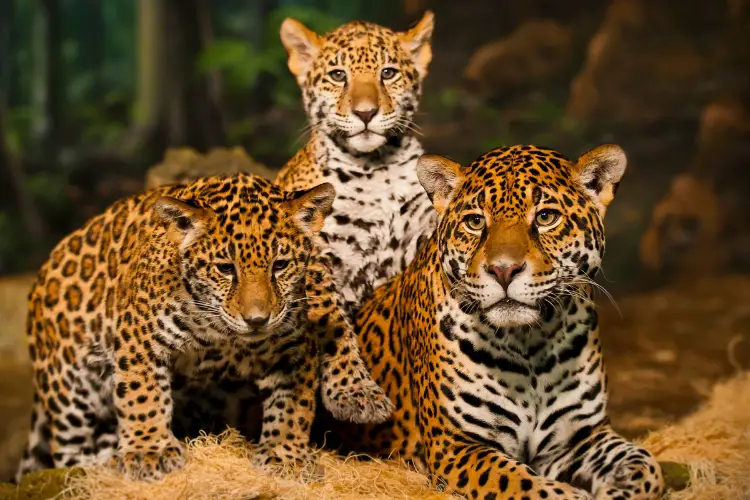The jaguar, a powerful and strikingly beautiful big cat, is a true emblem of the diverse and rich ecosystems of the Americas.
With its distinctive spotted coat, muscular build, and remarkable hunting skills, this feline predator has captivated humans for centuries.
In this comprehensive guide, we’ll delve into fascinating jaguar animal facts, unveiling the secrets of its biology, behavior, and conservation challenges.
Appearance and Physical Traits
The jaguar is the largest cat species in the Western Hemisphere and the third-largest in the world, after the tiger and lion. Here are some notable physical characteristics of this magnificent predator:
- Size and Weight: Adult jaguars typically measure between 5 and 6 feet (1.5 to 1.8 meters) in length, with males being larger than females. Their weight can range from 100 to 250 pounds (45 to 113 kilograms), with males generally weighing more than females.
- Coat Pattern: The jaguar’s coat is a stunning display of rosettes – dark spots with lighter centers – against a yellow or reddish-brown background. This distinctive pattern serves as excellent camouflage in the dappled light of their forest habitats.
- Powerful Build: With a broad head, muscular body, and strong jaws, the jaguar is built for power and precision. Its sturdy limbs and large paws enable it to swim, climb trees, and chase prey with remarkable agility.
- Distinctive Features: Jaguars have distinctive features, including a robust jawline, stocky legs, and a broad muzzle. Their eyes are large and forward-facing, granting them excellent binocular vision for hunting.

Habitat and Distribution
Jaguars are found across a wide range of habitats in the Americas, from the southwestern United States to northern Argentina. Their distribution and preferred habitats include:
- Tropical and Subtropical Moist Broadleaf Forests: These dense, lush forests provide ample cover and prey for jaguars, making them one of their primary habitats.
- Savannas and Grasslands: Jaguars can also thrive in open savannas and grasslands, where they hunt deer, peccaries, and other herbivores.
- Swamps and Wetlands: With their exceptional swimming abilities, jaguars are well-adapted to swampy and wetland environments, where they hunt aquatic prey like caimans and fish.
- Deserts and Scrublands: Although less common, jaguars can be found in arid regions, such as the deserts and scrublands of northern Mexico and the southwestern United States.

Diet and Hunting Strategies
As apex predators, jaguars play a crucial role in maintaining the balance of their ecosystems. Their diverse diet and impressive hunting abilities make them formidable hunters:
- Prey: Jaguars are opportunistic hunters and have a varied diet that includes deer, peccaries, capybaras, sloths, monkeys, fish, and even caimans (a species of alligator).
- Hunting Techniques: With their powerful jaws and sharp teeth, jaguars are capable of delivering a lethal bite to the skull or neck of their prey. They employ ambush tactics, stalking their prey from cover or waiting patiently near water sources.
- Adaptability: Jaguars are skilled swimmers and climbers, allowing them to pursue prey both on land and in the water or up trees. This versatility gives them an advantage over other big cats.
- Nocturnal Hunters: While they can hunt during the day, jaguars are primarily nocturnal, relying on their excellent night vision and acute hearing to locate prey under the cover of darkness.

Conservation Status and Threats
Despite their impressive hunting abilities and adaptability, jaguars face numerous threats that have led to population declines and conservation concerns:
- Habitat Loss and Fragmentation: Deforestation, urbanization, and agricultural expansion have resulted in the loss and fragmentation of jaguar habitats, reducing their available territory and prey base.
- Human-Wildlife Conflict: As human populations encroach on jaguar habitats, conflicts with livestock owners and hunters may arise, leading to retaliatory killings or poaching.
- Illegal Hunting and Wildlife Trade: Jaguars are poached for their fur, teeth, and other body parts, which are illegally traded in some regions.
- Prey Depletion: The overhunting of jaguar prey species, such as deer and peccaries, can indirectly impact jaguar populations by reducing their food sources.
Due to these threats, the jaguar is classified as “Near Threatened” on the International Union for Conservation of Nature (IUCN) Red List of Threatened Species. Efforts are underway to protect jaguar habitats, mitigate human-wildlife conflicts, and raise awareness about the importance of conserving this iconic big cat.

Fascinating Jaguar Facts
To further appreciate the unique characteristics of these formidable felines, here are some fascinating jaguar animal facts:
- Jaguars are excellent swimmers and have been known to hunt and kill prey in the water, including caimans and fish.
- They are the only big cats in the Western Hemisphere that roar, along with lions and tigers.
- Jaguars have the strongest bite force of any big cat relative to their size, capable of piercing the skull of their prey with ease.
- They are solitary animals, except during breeding seasons or when raising cubs.
- Jaguars are known for their exceptional agility and can climb trees, even with prey in their jaws.
- Their name derives from the indigenous Tupi-Guarani word “yaguarete,” which means “true beast.”
- Jaguars are considered a cultural icon and have been revered in various indigenous cultures throughout the Americas.

Conservation Efforts and How You Can Help
Protecting the jaguar and its habitats requires collective efforts from governments, organizations, and individuals alike. Here are some ways you can contribute to jaguar conservation:
- Support Conservation Organizations: Donate to or volunteer with organizations that work to protect jaguars and their habitats, such as the Jaguar Corridor Initiative, Panthera, and the World Wildlife Fund (WWF).
- Spread Awareness: Share information about the importance of jaguar conservation and the threats they face with your community, friends, and family.
- Reduce Your Environmental Footprint: Minimize your impact on the environment by reducing your carbon footprint, using sustainable products, and supporting eco-friendly initiatives.
- Responsible Travel: If you visit areas where jaguars are present, follow responsible tourism practices, respect wildlife viewing guidelines, and support local conservation efforts.
- Advocate for Policies: Support policies and regulations that protect jaguar habitats, address illegal hunting and wildlife trade, and promote sustainable development practices.
By taking these steps, we can help ensure the survival of these magnificent big cats and preserve the rich biodiversity of the Americas for generations to come.

Key Takeaways
| Fact | Description |
|---|---|
| Size and Weight | Adult jaguars measure 5-6 feet long and weigh 100-250 pounds, with males being larger than females. |
| Coat Pattern | Their distinctive rosette-patterned coat provides excellent camouflage in forest habitats. |
| Habitat and Distribution | Found across various habitats in the Americas, including tropical forests, savannas, wetlands, and deserts. |
| Diet and Hunting | Opportunistic hunters, they prey on deer, peccaries, caimans, and other animals, using ambush tactics and their powerful jaws. |
| Conservation Status | Listed as “Near Threatened” due to habitat loss, human-wildlife conflict, poaching, and prey depletion. |
| Unique Abilities | Excellent swimmers, climbers, and have the strongest bite force of any big cat relative to their size. |
| Cultural Significance | Revered in various indigenous cultures throughout the Americas as a cultural icon. |
The jaguar is a truly remarkable and iconic species, showcasing the diversity and resilience of life in the Americas. By understanding and appreciating these fascinating jaguar animal facts, we can foster a deeper connection with nature and contribute to the conservation of this magnificent big cat and its habitats.


